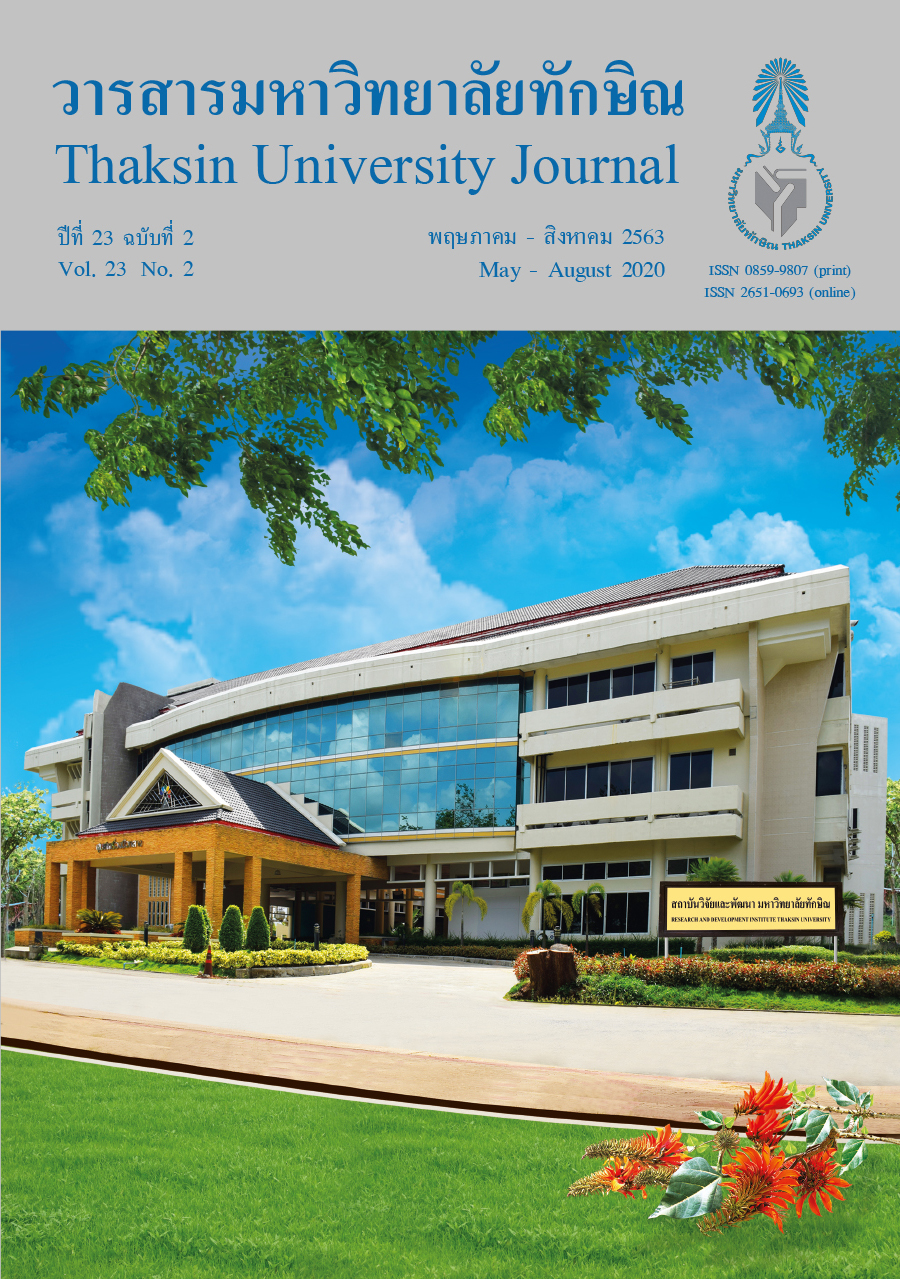ลักษณะทนแล้ง ผลผลิตและสหสัมพันธ์ระหว่างลักษณะทนแล้งกับผลผลิตของข้าวไร่พันธุ์แนะนำ
Main Article Content
บทคัดย่อ
ข้าวไร่มักจะให้ผลผลิตต่ำเนื่องจากปริมาณน้ำฝนไม่สม่ำเสมอตลอดฤดูปลูก ลักษณะสรีรวิทยาบางประการอาจสัมพันธ์กับความสามารถในการทนแล้งและการให้ผลผลิตของข้าวที่ปลูกในสภาพไร่ จึงได้ทำ 2 การทดลอง เพื่อศึกษาลักษณะสรีรวิทยาที่สัมพันธ์กับการทนแล้ง ผลผลิตและสหสัมพันธ์ระหว่างลักษณะสรีรวิทยาที่สัมพันธ์กับการทนแล้งกับผลผลิตของข้าวไร่ 5 พันธุ์ ประกอบด้วย เหนียวดำลืมผัว ซิวแม่จัน นุสรา ขุนวางและพญาลืมแกง โดยมี IR1552 บาเกียวและข้าวนาสวนพันธุ์ปทุมธานี 1 เป็นพันธุ์เปรียบเทียบ การศึกษาลักษณะสรีรวิทยาที่สัมพันธ์กับการทนแล้ง 4 ลักษณะ คือ ความยาวรากสูงสุด น้ำหนักรากแห้ง สัดส่วนระหว่างน้ำหนักรากแห้ง/น้ำหนักต้นแห้งและค่าการสูญเสียน้ำผ่านปากใบ (stomatal conductant) ที่อายุ 40 วันหลังปลูกในกระถาง ใช้แผนการทดลองแบบสุ่มสมบูรณ์ 3 ซ้ำ สุ่มบันทึกลักษณะ 10 กอ/หน่วยทดลอง ส่วนการทดลองเปรียบเทียบผลผลิตในสภาพไร่ใช้แผนการทดลองแบบสุ่มสมบูรณ์ภายในบล็อค 3 ซ้ำ ทดลองในฤดูฝน ปี พ.ศ. 2560 (ส.ค.-ธ.ค.) สุ่มบันทึกข้อมูลผลการทดลอง 10 กอ/หน่วยทดลอง ผลการทดลองพบว่า ข้าวไร่ทั้ง 5 พันธุ์มีลักษณะที่สัมพันธ์กับการทนแล้งทั้ง 4 ลักษณะดีกว่าข้าวพันธุ์ปทุมธานี 1 กล่าวคือ มีความยาวรากสูงสุด น้ำหนักรากแห้ง สัดส่วนระหว่างน้ำหนักรากแห้ง/น้ำหนักต้นแห้ง สูงกว่าพันธุ์ปทุมธานี 1 และมีที่ค่าการสูญเสียน้ำผ่านปากใบต่ำกว่าพันธุ์ปทุมธานี 1 นอกจากนี้พบว่า ความยาวรากสูงสุดและสัดส่วนระหว่างน้ำหนักรากแห้ง/น้ำหนักต้นแห้งมีสัมประสิทธิ์สหสัมพันธ์ (r) กับผลผลิตเป็นบวกอย่างมีนัยสำคัญ โดย r เท่ากับ 0.733** และ 0.565** ตามลำดับ
Article Details

อนุญาตภายใต้เงื่อนไข Creative Commons Attribution-NonCommercial-NoDerivatives 4.0 International License.
เอกสารอ้างอิง
Office of Agricultural Economics. (2019). Rice production 2017/18 (Online). Retrieved 10 January 2019, from http://www.oae.go.th/download/prcai/DryCrop/majorrice/3-60.pdf.
Thai Rice Exporters Association. (2019). Guidelines for FTA treatments 2018-2019 (Online). Retrieved 9 December 2019, from http://www.thairiceexporters.or.th/export%20by%20country%202019.html.
Rice Department. (2019). Rice varieties (Online). Retrieved 26 February 2019, from http://www.ricethailand.go.th/Rkb/varieties/index.php.html.
Pharwong, J., Jongdee, B., Panwan, G., & Laohasiriwong, S. (2012). Validation for drought tolerance genotypes in SURIN1 backcross introgression lines. Khon Kaen Agriculture Journal, 40, 229–236.
Srividhya, A., Vemireddy, L.R., Sridhar, S., Jayaprada, M., Ramanarao, P.V., Hariprasad, A.S., Reddy, H.K., Anuradha, G., & Siddiq, E. (2011). Molecular mapping of QTLs for yield and its components under two water supply conditions in rice (Oryza sativa L.). Journal of Crop Science and Biotechnology, 14(1), 45–56.
MacMillan, K., Emrich, K., Piepho, H.P., Mullins, C.E., & Price, A.H. (2006). Assessing the importance of genotype x environment interaction for root traits in rice using a mapping population II: conventional QTL analysis. Theoretical and Applied Genetics Technology, 113(5), 953–964.
Kanbar, A., Toorchi, M., & Shashidhar, H.E. (2009). Relationship between root and yield morphological characters in rainfed low land rice (Oryza sativa L.). Cereal Research Communications, 37(2), 261–268.
Phonwong, K., Sreewongchai, T., & Sripichitt, P. (2018). Phenotypic evaluation of root traits in F2 progenies from cross between lowland and upland rice. Thai Journal of Science and Technology, 7(5), 471–480.
Pushpam, R., Manonmani, S., Varthini, V.N., & Robin, S. (2018). Studies on yield, root characters related to drought tolerance and their association in upland rice genotypes. Electronic Journal of Plant Breeding, 9(3), 856–862.
Rice Department. (2019). Rice varieties: Pathum Thani 1 (Online). Retrieved 15 March 2019, from http://www.ricethailand.go.th/Rkb/varieties/index.php-file=content.php&id=67.html.
Narenut, K., Songsri, P., Pattanagul, W., & Sanitchon, J. (2013). Early drought tolerance evaluation of indigenous upland rice germplasm. Khon Kaen Agriculture Journal, 41(1), 663–647.
Sakuntong, Y., Thopurin, D., Madee, P., Theerakulpisut, P., Sanitchon, J., & Lontom, W.(2014). Leaf gas exchange, water status and electrolyte leakage of Luempua cultivar (Oryza sativa L.) under water deficit at seedling stage. In The 3rd National Rice Conference. 158–161. September 11-12, 2014, The Miracle Grand Convention Hotel. Bangkok: Thailand.
Junsawang, N., Sawatsri, N., Phengkaew, K., & Soonsuwon, W. (2019). Correlation and path analysis in BC2 F2 population of upland rice (Oryza sativa L.). Songklanakarin Journal of Plant Science, 6(1), 2–6.
Haider, Z., Khan, A.S., & Zia, S. (2012). Correlation and path coefficient analysis of yield components in rice (Oryza sativa L.) under simulated drought stress condition. American-Eurasian Journal of Agricultural & Environmental Science, 12(1), 100–104.
Mohankumar, M.V., Sheshshayee, M.S., Rajanna, M.P., & Udayakumar, M. (2011). Correlation and path analysis of drought tolerance traits on grain yield in rice germplasm accessions. ARPN Journal of Agricultural and Biological Science, 6(7), 70–75.


